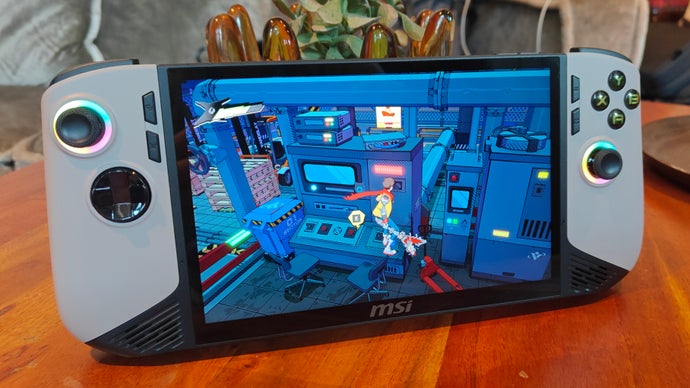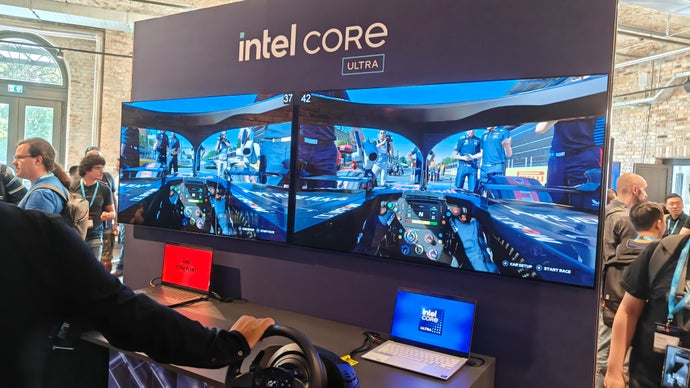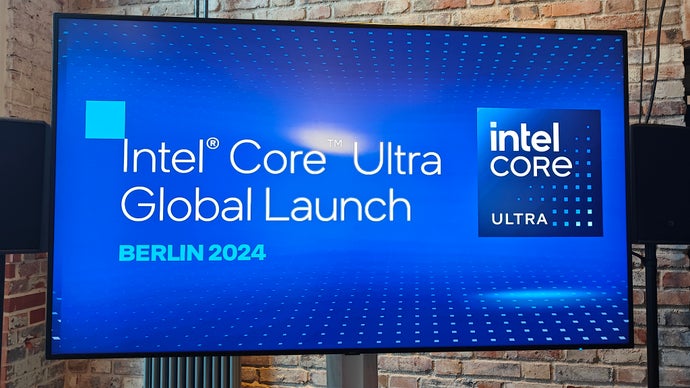Following their initial reveal at Computex earlier this year, Intel has fully unveiled its new ‘Lunar Lake’ laptop CPUs at a press event in Berlin. The new Core Ultra 200V chips look impressive, offering significantly better performance at lower power levels than last year’s first-gen Core Ultra ‘Meteor Lake’, with graphics and AI performance being areas of particular improvement. In fact, the new top-level chips are even fast enough for RT gaming at decent frame-rates – something I definitely didn’t expect to be a focus of Intel’s presentation!
Let’s rattle through some numbers quickly. Intel says that its fastest Core Ultra 200V chip has seen its single-core speeds improve by around 18 percent versus the last-gen, while the GPU has improved by 30 percent on average across a 45-game sample. Meanwhile, package power has dropped by 40 to 50 percent versus Meteor Lake, granting nearly a doubling of performance per watt, while AI performance has tripled in some applications.
We all know that the proof of the pudding is in the tasting, so we won’t pass final comment yet – but Intel’s performance claims and hands-off live demos do smell great. Lunar Lake laptops are available for pre-order now from a variety of vendors – Acer, Asus, Dell, HP, Lenovo, LG, MSI, Samsung – but, as always, we’d advise you to wait for third-party benchmarks if you can.
Attribution
Taking Intel’s claims as read for now then, how has this major uptick of performance and efficiency been achieved? According to Intel VP Robert Hallock, the team aimed for a performant 9W laptop chip, then scaled up to higher power parts – 20W, 30W and 37W as the fastest option – in response to requests from its laptop makers.
Interestingly, all nine (!) of Intel’s Core Ultra 200V SKUs announced today use the same basic design, which combines four Lion Cove P-cores with four Skymont E-cores. Simultaneous multi-threading (SMT) has been jettisoned to save on power, so every part has a maximum of eight threads. However, 16GB or 32GB of LPDDR5X 8533MT/s memory has been brought on-die to cut power and aid latency, while on-board graphics have also been beefed up significantly with up to eight Xe2 cores.
The difference between the different models then comes down to relatively minor factors: turbo frequencies (4.5 to 5.1GHz P-cores, 3.5 to 3.7GHz E-cores), cache size (12MB or 8MB), GPU grunt (Arc 140V or 120V), neural compute engines (five or six Gen4 NPUs) and base power ratings (8W-17W for all but the top-end part, which gets 17W-30W).
It’s those graphics claims that are perhaps the most exciting, so I want to zero in on those now, with Intel claiming bigger RT units, more effective XeSS upscaling and just better performance overall in general. The Xe architecture has already shown significant promise, but the performance improvements with Xe2 allow an extremely slim laptop to run a decent number of recent games at 1080p medium settings (with XeSS in performance mode where available) and get 60fps readouts – see the slides above for the full details. Intel also performed a live demo for assembled press, showing Shadow of the Tomb Raider, which averaged 73fps in live tests, and Cyberpunk 2077, which managed 61fps average and 49fps minimum at the same settings.
If you prefer fidelity, you can opt for RT and get a relatively stable performance, with Intel’s slides promising average frame-rates of 45fps in Cyberpunk 2077, 57fps in Marvel’s Spider-Man Remastered, 66fps in Shadow of the Tomb Raider, 74fps in F1 24 and 79fps in Hitman 3. The latter three examples are games that have relatively limited RT compared to the likes of Alan Wake 2 or Control, but that’s still almost unthinkable levels of RT grunt for a laptop of this size and capability.
Intel had a hands-on demo of F1 24 running on Lunar Lake and AMD Strix Point laptops at matched settings, and the Lunar Lake model was not only a touch higher on average, but seemed to avoid the huge stutters that afflicted the AMD-powered machine throughout the lap. It’ll be fascinating to see exactly the kind of performance we can expect when we can run one of these laptops through our benchmarking suite, but it felt noticeably smoother and I was able to put together a pretty tidy lap around Monza – while an opponent on the AMD machine was not nearly so lucky.


The new chipset is also set to be used in gaming handhelds, with MSI demoing an updated version of the Claw that’ll be revealed in full for CES in January. We weren’t able to freely check performance, but the system flew through Hi-Fi Rush and looked genuinely great on the handheld’s eight-inch display. The MSI representative told us that the new model has some ergonomic improvements as well as a chipset swap, and that a smaller seven-inch model for smaller hands is also planned.
While gaming results are the most exciting for us nerds at Digital Foundry, battery life is arguably more important for people that actually tend to buy these machines for work. Intel did show some interesting results from an unnamed OEM that sells the same exact same chassis with an option for either an Intel Core Ultra 7 268V or Qualcomm XIE-80-100 chipset inside. Office productivity battery life tests showed a small lead for the Intel-powered variant, 20.1 hours to 18.4, while the Qualcomm machine eclipses the Intel in a Microsoft Teams call, 12.7 hours versus 10.7 hours. A similar comparison with AMD and Qualcomm, albeit without as closely matched components, showed Intel claiming the longevity lead over both rivals.
Overall, it’s been a fascinating reveal that went beyond what I personally expected and I can’t wait to test some of these chips in the usual DF fashion once laptop samples start shipping. Our greater focus will no doubt be on the next generation of desktop-class chips that are rumoured to keep some time around the end of the year, but the competition in the ultraportable space right now is truly impressive, with Intel joining Qualcomm, AMD and Apple in fierce combat.

It’s also game on for laptop makers, who are all trying to stand out in what is a very tightly controlled spec. I tried out laptops from Dell, Asus, MSI and LG at the event, which were all suitably impressive feats of engineering, stuffing significant power into super-strong 13-inch and 1kg chassis.
However, it was the last Lunar Lake laptop I tried, a Samsung Galaxy Book model, that left the biggest impression – and therefore gets to be the article thumbnail above. That was thanks to a 16-inch AMOLED screen that could get bright enough to withstand the full 32°C glare of the Berlin sun, while also hitting a comfortable 2880×1800 at 120Hz. Add in a magnetic pen and the ecosystem advantages of being one of the biggest Android phone makers, like wireless phone mirroring, and you’ve got some genuine differentiation.
Of course, going hands-on in a demo room is one thing, living with a device day-to-day and running it through a benchmark suite is another. All I can say is that I’m genuinely excited about the laptop space in a way that I haven’t been for quite some time.
Intel provided flights and accommodation to attend their press briefings at IFA.
